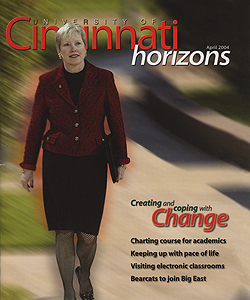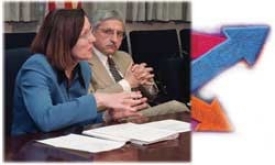by Deborah Rieselman
"Will we chart our future, or will we drift into it?"
The question was obviously rhetorical. None of the 50 University of Cincinnati leaders to whom it was posed would have argued for drifting. Nevertheless, many knew that, at times, parts of the institution had become adept at it.
President Nancy Zimpher identified the situation immediately upon her arrival in October 2003 and started laying the foundation for what she calls a Comprehensive Academic Planning Process. In December, she initiated the process with a "listening session" for UC's leaders to discuss the concept, but she announced her goal soon after her arrival in October.
"I have learned that vision trumps everything," she commented at her first address to the entire faculty in October. "I know that organizations are most effective when a well-articulated and ambitious vision of the future exists, reflecting the rich traditions of the past, as well as our aspirations for the future. With the Campus Master Plan as a model, we must frame our ambitions and aspiration to become truly premier and world class."
In terms of making the physical campus world class, it's hard to overlook the success that came when the administration coordinated campus construction within the guidance of an overall plan. "The lessons learned during the development of the Campus Master Plan," says vice president of finance Dale McGirr, "demonstrate that more can be accomplished by planning together, rather than separately. It is helpful to have a set of unchanging or slowly evolving principles in the plan, as well as a dynamic section reflecting emerging issues."
The process may seem like nothing new for an institution that is forever planning, but never before has UC done it so globally and comprehensively in regard to academia. Rather than critiquing individual programs, this study will look at UC's unique characteristics, rankings, aspirations and new definitions of excellence, then chart a course based upon desired outcomes.
"What kind of students do we want to produce?" asks Kristi Nelson, vice provost of academic planning. "When they leave here, what would be the distinctive features of a UC graduate? How do we create programs that produce that kind of graduate? That is what we are talking about."
No one disputes that it was time for taking such a view. "It's long overdue," says Richard Karp, Faculty Senate chair and biology professor. "It's the only way to intelligently plan to use our resources in the most advantageous way to improve the institution and the quality of education we deliver."
Expanding steadily since 1819, the university had virtually grown at odds with itself. Individual components had advanced in nationally recognized ways, while functioning within a structure that, at times, had been left to evolve.
Historically, UC had been harvesting from the city's garden of colleges, selecting the choicest fruit and plopping it in a basket -- a law school here, a nursing school there, a music conservatory nestled in between. The university isn't so much a cultivated crop, as it is a fine collection of exotic flora.
Consequently, cultivation techniques were not standardized. Individual colleges easily clung to their own traditions. Faculty and staff, in many cases, fought for what was best for their programs, but not the entire system. Some alumni saw themselves as graduates from a college or program, but not from UC as a whole.
The institution unwittingly perpetuated that "silo" mentality by restricting freshman admission into individual colleges. In contrast, freshmen at some universities can apply for general admission, then decide in which college to focus their studies.
"We've been trying to topple those silos already," provost Tony Perzigian says. But correcting global problems is complicated, and change painful. So campus visionaries are taking deliberate and careful steps as they lay the framework for UC's academic plan.

 Past Issues
Past Issues
